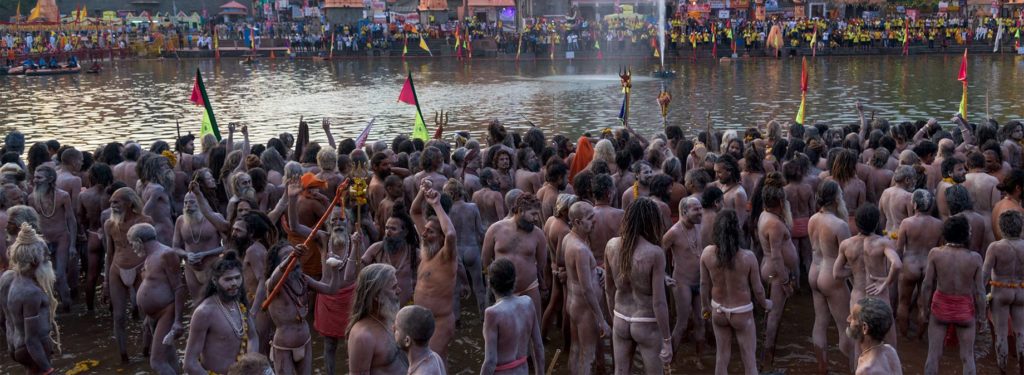
This itself establishes the significance of the Kumbh as symbolized by the pitcher. The main thing to do during this pilgrimage is take a bath in the holy rivers Ganga, Yamuna and the mythical river the Saraswati who join together at Allahabad. In 2013 they expect more than 70 million participants from all over the world. Holy scriptures say that in a pitcher, its mouth (opening) symbolizes the presence of Vishnu, its neck that of Rudra, the base of Brahama, all goddesses in the center and the entire oceans in the interior, thus encompassing all the four Vedas. Maha Kumbh Mela is the biggest Hindu pilgrimage and event there is. Even as a symbol of pitcher, Kumbh is synonymous with holy activities as in daily life a pitcher (or kalash) is an integral part of all sacred activities in Hindu culture, and this pitcher is a symbol of Kumbh. The literal meaning of Kumbh is a pitcher, but its elemental meaning is something else. In fact Prayag and Kumbh are synonymous to each other. The Dashashwamedh Ghat and the Brahmeshwar Temple still exist here as if as symbols of that holy yagna, and that is another reason for the special significance of the Prayag Kumbh. Prajapati Brahma, the God of Creation, is said to have created the Universe after conducting the Ashwamedh Yagna at the Dashashwamedh Ghat here. This is the place where the sun, symbolizing wisdom, rises.Ĭreation of the universe is supposed to have originated here and it is supposed to be the center of the earth. It is a remarkable event where millions of devotees gather to take a dip in the holy Triveni Sangam of Ganga, Yamuna and Saraswati rivers. The most significant among them is the Maha Kumbh Mela held in Allahabad once every 144 years. Prayag Kumbh is considered to be the most significant of all as it marks the direction of wisdom or light. It is hosted by four major Indian cities, namely Prayagraj (formerly Allahabad), Nashik, Ujjain, and Haridwar. At Haridwar and Prayagraj, an Ardha ("Half") Kumbh Mela is held every sixth year a Maha ("Great") Kumbh Mela occurs after 144 years. At Nashik and Ujjain, the Mela may be held while a planet is in Leo (Simha in Hindu astrology) in this case, it is also known as Simhastha. Kumbh Maha Snan or main bathing day during Kumbh Mela falls on Amavasya day. This Kumbh would be Purna Kumbh which repeats every 12 years.

The exact date is determined according to a combination of zodiac positions of the Jupiter, the Sun and the Moon. In 2013 Kumbh Mela would be held at Allahabad, which is also known as Prayag. There is a difference of around 3 years between the Kumbh Melas at Haridwar and Nashik the fairs at Nashik and Ujjain are celebrated in the same year or one year apart. Bathing in these rivers is thought to cleanse a person of all sins.Īt any given place, the Kumbh Mela is held once in 12 years. The Maha Kumbh Mela (Great Kumbh Mela) took place in Allahabad in 2013 and attracted more than 100 million people.

The main festival site is located on the banks of a river: the Ganges (Ganga) at Haridwar the confluence (Sangam) of the Ganges and the Yamuna and the invisible Sarasvati at Prayagraj the Godavari at Nashik and the Shipra at Ujjain. The Kumbh Mela is the biggest hindu pilgrimage and the largest gathering of human beings for a single religious purpose in the world.

These four fairs are held periodically at one of the following places by rotation: Haridwar, Prayagraj (Allahabad), Nashik district (Nashik and Trimbak) and Ujjain. Traditionally, four fairs are widely recognized as the Kumbh Melas: the Haridwar Kumbh Mela, the Prayagraj Kumbh Mela, the Nashik-Trimbakeshwar Simhastha and the Ujjain Simhastha, although priests at other places have also claimed their local fairs to be Kumbh Melas. The main thing to do during this pilgrimage is take a bath in the holy rivers Ganga, Yamuna and the mythical river the Saraswati who join together at Allahabad.Kumbh Mela is a mass Hindu pilgrimage of faith in which Hindus gather to bathe in a sacred river. Maha Kumbh Mela is the biggest Hindu pilgrimage and event there is.


 0 kommentar(er)
0 kommentar(er)
